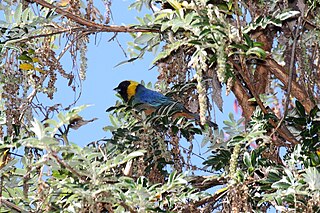
The chestnut-necklaced partridge is a species of bird in the family Phasianidae. It is found in forests in the Malay Peninsula and Sumatra. It is threatened by habitat loss and trapping. The International Union for Conservation of Nature (IUCN) has assessed it as vulnerable.
The black-hooded coucal is a species of cuckoo in the family Cuculidae. It is endemic to Mindoro in the Philippines and is one of the most endangered birds in the country. It is threatened by habitat loss and trapping.

The blue-winged racket-tail or Sulu racquet-tail is a species of parrot in the family Psittaculidae. It is endemic to Tawi-Tawi island in the Philippines and is one of the most endangered parrots in the world. It is threatened by habitat loss and the poaching for the cage-bird trade.

Hombron's kingfisher or the blue-capped kingfisher is a species of bird in the family Alcedinidae endemic to the Philippines and found only on Mindanao. It is one of the most colorful kingfishers in the country having a dark blue cap and wings with rufous spots, a striped rufous belly, white chin and red bill. Its natural habitats are on the upper ranges of tropical moist lowland forest and tropical moist montane forests. It is threatened by habitat loss.

The purplish jay is a species of bird in the family Corvidae. It is found in northern Argentina, Bolivia, southern Brazil, Paraguay and southeastern Peru. Its natural habitats are subtropical or tropical dry forest, subtropical or tropical moist lowland forest, and heavily degraded former forest.

The Andaman treepie is a species of bird in the family Corvidae. First described by Robert Christopher Tytler in 1863, it is endemic to the Andaman Islands of India, where its natural habitat is subtropical or tropical moist lowland forests. It is threatened by habitat loss.

The brown-backed flowerpecker is a species of bird in the family Dicaeidae. The scientific name commemorates British colonial administrator and zoological collector Alfred Hart Everett.

The forest fody is a species of bird in the family Ploceidae. It is endemic to Madagascar.

The yellow-throated tanager is a species of bird in the family Thraupidae. It is found in Colombia, Ecuador, and Peru. Its natural habitat is subtropical or tropical moist montane forests.

The golden-collared tanager is a species of bird in the family Thraupidae. It is found in Bolivia and Peru. Its natural habitat is subtropical or tropical moist montane forests.

The yellow-scarfed tanager is a species of bird in the family Thraupidae. It is found in forests in the Andean highlands in Peru.

The golden-crowned tanager is a species of bird in the family Thraupidae.
The Mount Kupe bushshrike is a species of bird in the family Malaconotidae. It was previously thought to be endemic to Cameroon, where it is found in the Bakossi Forest Reserve and in particular on Mount Kupe. In 2011 it was reported to be present in two sites in south east Nigeria.

The Boano monarch, or black-chinned monarch, is a species of bird in the family Monarchidae endemic to Indonesia. It is found on Boano island in the southern Mollucas. Its natural habitats are subtropical or tropical moist lowland forest and subtropical or tropical moist shrubland. It is threatened by habitat loss.

The Biak monarch, or Biak monarch flycatcher, is a species of bird in the family Monarchidae. It is endemic to Biak Island, Indonesia.

The giant sunbird is a species of bird in the family Nectariniidae. It is the only species in the genus Dreptes. It is endemic to the island of São Tomé, where it occurs in the central massif.

The São Tomé oriole, or great-billed oriole, is a species of bird in the family Oriolidae. The species was named by Gustav Hartlaub in 1857. It is endemic to the island of São Tomé. Its natural habitats are subtropical or tropical moist lowland forests and subtropical or tropical moist montane forests. It is threatened by habitat loss.

The Sulu pygmy woodpecker, also known as the Sulu woodpecker, is a species of bird in the family Picidae. Formerly lumped with the Philippine pygmy woodpecker, it seems to form a superspecies with this and the Sulawesi pygmy woodpecker. Some taxonomic authorities continue to place this species in the genus Dendrocopos or Picoides.

Ward's trogon is a species of bird in the family Trogonidae. Its range includes the northeastern parts of the Indian subcontinent stretching eastwards to Southeast Asia. It is found in Bhutan, India, Tibet, and Myanmar. It also has a disjunct population in northern Vietnam, but there are no recent records from there. Its natural habitats are temperate forests and subtropical or tropical moist lowland forests. It is threatened by habitat loss.

The Hispaniolan trogon is a species of bird in the family Trogonidae. It is endemic to Hispaniola in the Caribbean. It is one of the only two trogon species found in the Caribbean. It is the national bird of Haiti.




















